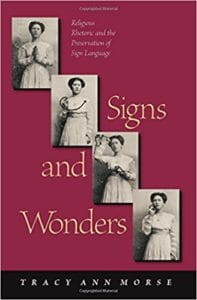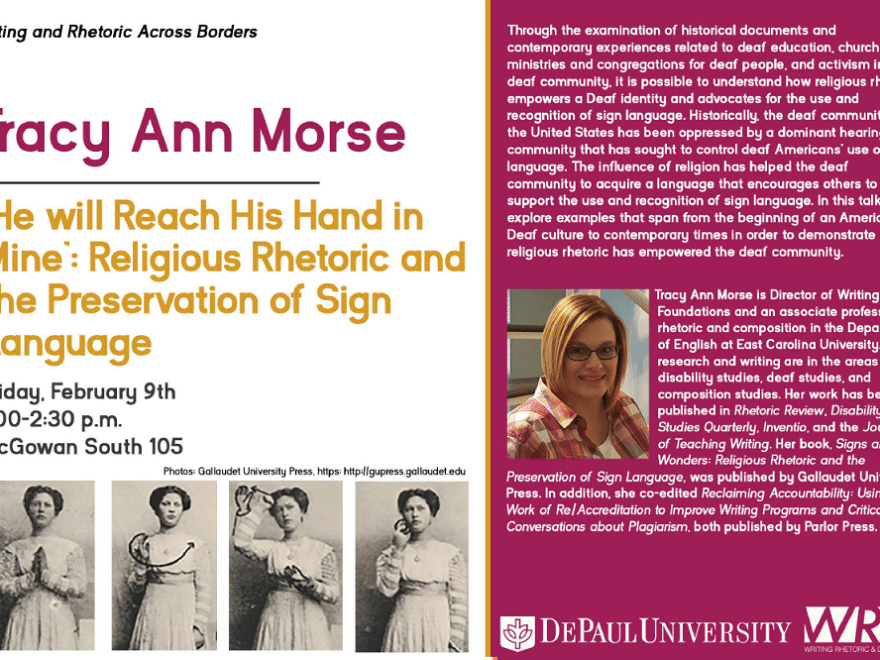As part of our ongoing speaker series, the WRD Department welcomed Tracy Ann Morse on Friday, February 9th. Morse is the Director of Writing Foundations and an Associate Professor of rhetoric and composition in the Department of English at East Carolina University, and author of Signs and Wonders: Religious Rhetoric and the Preservation of Sign Language.  Morse’s talk, “He will Reach His Hand in Mine: Religious Rhetoric and the Preservation of Sign Language,” discussed research from her book on the connection between religious rhetoric and the history of oppression against deaf Americans. Morse shared examples of attempts at preserving American Sign Language (ASL) and securing rights for deaf Americans that draw on religious rhetoric and themes, both in the past and in contemporary activism and pop culture.
Morse’s talk, “He will Reach His Hand in Mine: Religious Rhetoric and the Preservation of Sign Language,” discussed research from her book on the connection between religious rhetoric and the history of oppression against deaf Americans. Morse shared examples of attempts at preserving American Sign Language (ASL) and securing rights for deaf Americans that draw on religious rhetoric and themes, both in the past and in contemporary activism and pop culture.
Religious Rhetoric and the Founding of ASL
In the first part of her talk, Morse focused on the history of religious rhetoric in the founding of sign language in the United States. According to Morse, there were instructors, referred to as “oralists,” who believed that Deaf people should be taught to use spoken language rather than allowed their own sign language. Advocates for teaching sign language to Deaf Americans “evoked biblical themes and references” in order to persuade others to their cause, claiming a religious and ethical imperative to save the souls of the Deaf by giving them a language that allowed them to fully hear and accept religious teachings. Morse’s research focuses on how this religious rhetoric has impacted the culture and language of Deaf Americans throughout history and today.
The Preservation of Sign Language
During her talk Morse showed a seminal silent film from 1913 titled “the Preservation of Sign Language,” made by then-President of The National Association of the Deaf, George Veditz. This 14-minute film utilized “biblical rhetoric to condemn the oralists” and to support the continuation of sign language. The creation of the film itself served a dual purpose, as it was also a way to record sign language and preserve it in a time when the usage of sign language was being prosecuted and its future uncertain. This film represents one of the many instances where religious rhetoric was directly tied with sign language and its preservation
Deaf West Theater
At the end of her talk Morse touched on how religious rhetoric still plays a role in modern sign language by discussing Death West Theater, a theater company that performs spoken and signed productions with a mix of hearing and deaf actors. According to Morse, plays such as Huckleberry Finn evoke classic protestant themes and tie them directly to deaf struggles. In this way Deaf West Theater uses religious rhetoric and well-known stories to promote a deaf identity to the general public.
Conclusion
As the second lecture in WRD’s Writing and Rhetoric Across Borders Speaker Series, Tracy Morse’s talk was a compelling look at an overlooked language community grounded in historical events and rhetorical theory. Her talk was a reminder of how the past influences our language practices in unforeseen ways as well as an informative overview of the founding of American Sign Language.
